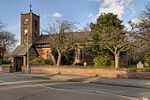Sankey Viaduct

The Sankey Viaduct is a railway viaduct in North West England. It is a designated Grade I listed building and has been described as being "the earliest major railway viaduct in the world".In 1826, the Liverpool and Manchester Railway Company (L&MR) was authorised to construct the world's first intercity railway. One obstacle on the selected 31-mile (50 km) route between Liverpool and Manchester was the Sankey Valley. The company's principal engineer, George Stephenson, designed the Sankey Viaduct for the double-track railway to traverse the valley and Sankey Canal with sufficient clearance for the masts and sails of the Mersey flats that used the canal.The viaduct was built between 1828 and 1830, although work on the structure did not finish until the middle of 1833. On 15 September 1830, the viaduct was opened along with the Liverpool & Manchester railway. During 2015, Network Rail installed overhead line equipment as part of a wider electrification programme.
Excerpt from the Wikipedia article Sankey Viaduct (License: CC BY-SA 3.0, Authors, Images).Sankey Viaduct
Scarborough Drive,
Geographical coordinates (GPS) Address External links Nearby Places Show on map
Geographical coordinates (GPS)
| Latitude | Longitude |
|---|---|
| N 53.44745 ° | E -2.65076 ° |
Address
Nine Arches (9 Arches)
Scarborough Drive
WA12 9AP , Newton Common
England, United Kingdom
Open on Google Maps









